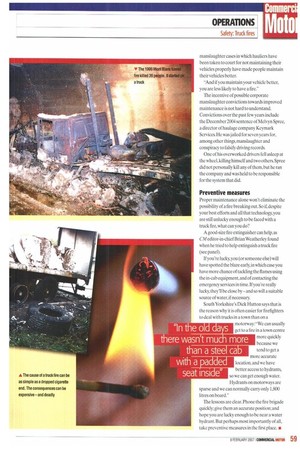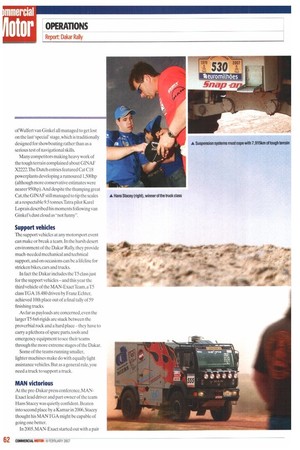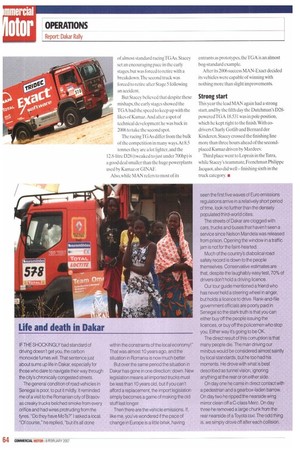BU RN N
Page 56

Page 57

Page 59

Page 60

Page 61

Page 62

Page 64

If you've noticed an error in this article please click here to report it so we can fix it.
SSIJES
An average of 40 trucks a week catch fire on UK roads, and it is not only hauliers who pay the price. Other vehicles can become involved leading to injuries and deaths; roads are routinely closed and sometimes need to be resurfaced.
Even so, things could be worse.The latest figures from the Department for Transport suggest the number of truck fires is falling, although the trend is not consistent (see panel). In 1994 the fire brigade was called to 2,373 truck fires and in 2004 (the most recent official figures) this had fallen to 2,046. But in between, the number of incidents peaked at 2,548 (1996) and dropped as low as 2,020 (2002), so improvement has been more stuttering than steady.
Car fires outnumber truck fires by more than 20:1, but the average truck fire takes the emergency services 138 minutes to deal with and closes 1.36 road lanes, compared with 39.4 minutes and 1.22 lanes for ears and vans.
Station Officer Terry Jewell, of Essex Fire Service, who is himself a former truck driver, says: -Trucks carry much more fuel and the position of the driver often causes a problem. It is harder to get to someone caged into a heavily built object six feet in the air than it is to get to someone at ground level."
He reports that most truck fires happen as a result of road traffic accidents and drivers are at extra risk because "quite a lot of them don't wear seat belts".
Behind the statistics lie some bruising human stories. Haulier Michael Pain was very proud of his new Scania Topline R470 — it won a Highly Commended award in the Peak Show last year. But that award was of little comfort when a fire broke out underneath the wagon on the M4 a week later. Pain managed to save the load by uncoupling the trailer. But, by the time the fire brigade arrived, the tractor unit was destroyed. hauliers of half a century ago as they are now, Geoff Day, head of engineering policy at the Freight Transport Association, suggests that the most common causes include bearings getting too hot, seals on oil filters breaking, faulty wiring and under-inflated tyres overheating.
As many drivers have discovered,one of the features of blazes triggered by overheated tyres is that they usually begin after the truck has come to a halt,losing the rush of cold air. Other familiar causes cited by Day include throwing cigarette ends out of the window only for it to be drawn into the air filter behind the cab.
The forthcoming ban on smoking in the cab will eliminate this risk, along with others: Steve Biddle, the Road Haulage Association's head of technical services, points out that some cab fires are caused by drivers discarding cigarette butts from their seat or a bunk. He adds that while fire-retardant technology has advanced considerably, there's more fuel:"In the old days, there wasn't much more than a steel cab with a padded chair inside; now, there are all sorts of materials inside, including beds and curtains.There is much more to burn if a fire does start."
Electronics
While modern cabs may contain more materials that burn, everybody seems to agree truck fires are becoming less frequent because vehicle technology is more reliable. With the caveat that increased use of electronics can provide more starting points for fires, the widely held view is that improved technology is usually safer technology Dick Hutton is a senior instructor from the South Yorkshire fire service seconded to the Fire Service College at Moreton-in-Marsh, Glos. He believes vehicles have improved enormously: "Most haulage vehicles used to look agricultural, and now they are more like Rol ls-Royces.The change has been huge," He adds that better technology is not the only reason that fires are getting slightly less common: "In recent years, particularly in the last decade, the publicity given to corporate manslaughter cases in which hauliers have been taken to court for not maintaining their vehicles properly have made people maintain their vehicles better.
"And if you maintain your vehicle better, you are less likely to have a fire."
The incentive of possible corporate manslaughter convictions towards improved maintenance is not hard to understand. Convictions over the past few years include the December 2004 sentence of Melvyn Spree, a director of haulage company Keymark Services. He was jailed for seven years for, among other things,manslaughter and conspiracy to falsify driving records.
One of his overworked drivers fell asleep at the wheel, killing himself and two others. Spree did not personally kill any of them, but he ran the company and was held to be responsible for the system that did.
Preventive measures
Proper maintenance alone won't eliminate the possibility of a fire breaking out. So if, despite your best efforts and all that technology, you are still unlucky enough to be faced with a truck fire, what can you do?
A good-size fire extinguisher can help, as CM editor-in-chief Brian Weatherley found when he tried to help extinguish a truck fire (see panel).
If you're lucky, you (or someone else) will have spotted the blaze early, in which case you have more chance of tackling the flames using the in-cab equipment, and of contacting the emergency services in time. If you're really lucky, they'll be close by — and so will a suitable source of water, if necessary, South Yorkshire's Dick Hutton says that is the reason why it is often easier for firefighters to deal with trucks in a town than on a motorway: "We can usually get to a fire in a town centre
"In the old da s
more quickly because we tend to get a more accurate location, and we have better access to hydrants, so we can get enough water. Hydrants on motorways are sparse and we can normally carry only 1,800 litres on board."
seat inside"
The lessons are clear. Phone the fire brigade quickly:give them an accurate position: and hope you are lucky enough to be near a water hydrant. But perhaps most importantly of all, Lake preventive measures in the first place. iiI t doesn't matter what you use, as long as it's got wheels. Race you to Dakar!" With those immortal words, Frenchman Thierry Sabine launched the ParisDakar Rally in 1978. And 29 years later, the greatest tough-terrain event on earth has lost none of its appeal.
The Dakar Rally is a bit like throwing a large suitcase full of cash into the Trevi Fountain: there is a high chance your money will sink to the bottom without trace. But still they come — although a massive corporate presence means the once comical side of the Dakar entrants has all but gone.
In recent years the Dakar has become a battle of East vs West — Karnaz,Tatra and Hino have been the teams to beat. It seems like yesterday, but it is almost 20 years since we were treated to blistering TV footage of Jan de Rooy's Daf, which won the four-wheel-drive category helped by twin engines and an awesome 1,200bp. As is still the case, weight was also an overriding factor — De Rooy's worryingly fast power pack was strapped to an ultra-lightweight aluminium frame.
That aside, you could argue that the two week-long event is won more on reliability than anything else.At one time there were no speed limits at all now it's 150km/h, Competitors are tracked and traced, and penalised if they exceed the speed limits.
So has the Dakar gone soft? Hardly—more than a third of the trucks registered to start in Lisbon failed to make it to the 15th and final stage in Dakar. As the old saying goes: "To finish first, first you have to finish." That's the point for manufacturers who take the event seriously: they reap the benefits of product enhancement.The pounding these trucks receive across almost 8,00km and 15 arduous stages is phenomenal. Over the years engineers have developed suspension systems that can survive that pounding. Some, such as Czech manufacturer Tatra, have favoured air, but most use single or twin hydraulic or hydropneumatic dampers. Daf was the first team to fit bypass shock absorbers, enabling them to reduce rear suspension to a single leaf spring.
No Dakar event would be complete without drama, especially when it comes to things such as engine outputs or deviations from the rulebook or the route.
Even Hans Stacey, the eventual winner of the truck class, made his fair share of deviations along the way. But bizarrely, Stacey, Ilgizar Mardeev and the Cat-powered GINAF of Wulfert van Ginkel all managed to get lost on the last 'special' stage, which is traditionally designed for showboating rather than as a serious test of navigational skills.
Many competitors making heavy work of the tough terrain complained about GINAF X2222.The Dutch entries featured Cat C18 powerplants developing a rumoured 1,500hp (although more conservative estimates were nearer 950hp). And despite the thumping great Cat, the GINAF still managed to tip the scales at a respectable 95 tonnes.Tatra pilot Karel Loprais described his moments following van Ginkel's dust cloud as "not funny".
Support vehicles
The support vehicles at any motorsport event can make or break a team. In the harsh desert environment of the Dakar Rally, they provide much-needed mechanical and technical support, and on occasions can be a lifeline for stricken bikes, cars arid trucks.
In fact the Dakar includes the T5 class just for the support vehicles — and this year the third vehicle of the MAN-Exact Team, a T5 class TGA 18.480 driven by Franz Echter, achieved 10th place out of a final tally of 59 finishing trucks.
As far as payloads are concerned, even the larger T5 6x6 rigids are stuck between the proverbial rock and a hard place — they have to carry a plethora of spare parts, tools and emergency equipment to see their teams through the more extreme stages of the Dakar.
Some of the teams running smaller, lighter machines make do with equally light assistance vehicles. But as a general rule, you need a truck to support a truck.
MAN victorious
At the pre-Dakar press conference, MANExact lead driver and part owner of the team Hans Stacey was quietly confident. Beaten into second place by a Kamaz in 2006, Stacey thought his MAN TGA might be capable of going one better.
In 2005. MAN-Exact started out with a pair of almost standard racing TGAs. Stacey set an encouraging pace in the early stages, but was forced to retire with a breakdown.The second truck was forced to retire after Stage 5 following an accident.
But Stacey believed that despite these mishaps, the early stages showed the TGA had the speed to keep up with the likes of Kamaz. And after a spot of technical development he was back in 2006 to take the second spot.
The racing TGAs differ from the bulk of the competition in many ways.At 8.5 tonnes they are a lot lighter, and the 12.8-litre D28 (tweaked to just under 700hp) is a good deal smaller than the huge powerplants used by Kamaz or GINAE Also, while MAN refers to most of its entrants as prototypes, the TG A is an almost bog-standard example.
After its 2006 success MAN-Exact decided its vehicles were capable of winning with nothing more than slight improvements.
Strang start
This year the lead MAN again had a strong start, and by the fifth day the Dutchman's D28poweredTGA 18.531 was in pole position, which he kept right to the finish.With codrivers Charly Gotlib and Bernard der Kinderen, Stacey crossed the finishing line more than three hours ahead of the secondplaced Kamaz driven by Mardeev.
Third place went to Loprais in the Tatra, while Stacey's teammate, Frenchman Philippe Jacquot, also did well finishing sixth in the truck category. •


























































































































































































